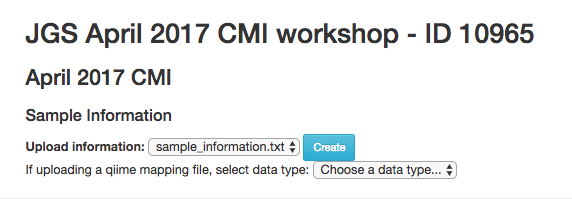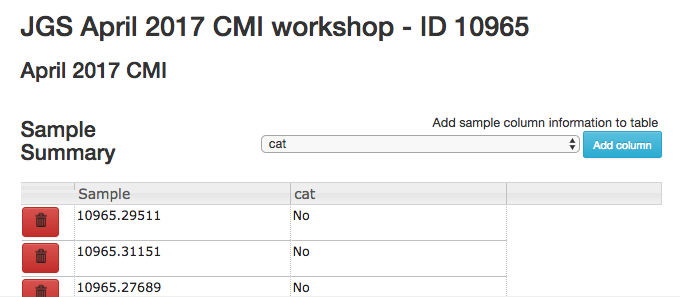This tutorial will walk you through creation of your account and a test study in Qiita.
Getting CMI Workshop example data¶
First, we’ll download some example data. These files contain both 16S and shotgun metagenomics data for 12 samples from the American Gut Project.
For this tutorial, the relevant files are:
qiita-files/16S/*.fastq.gz # The actual 16S sequences, one per sample
qiita-files/sample_information.txt # The sample information file
qiita-files/prep_template_16S.txt # The prep information file
Next, we’ll sign up for Qiita and create a study for these data.
Setting up Qiita¶
Signing up for a Qiita account¶
Open your browser (it must be Chrome or Firefox) and go to Qiita (https://qiita.ucsd.edu).
Click on “New User”.


The “New User” link brings you to a page on which you can create a new account. Optional fields are indicated explicitly, while all other fields are required. Once the form is submitted, an email will be sent to you containing instructions on how to verify your email address.
Logging into your account and resetting a forgotten password¶
Once you have created your account, you can log into the system by entering your email and password.

If you forget your password, you will need to reset it. Click on “Forgot Password”.

This will take you to a page on which to enter your email address; once you click the “Reset Password” button, the system will send you further instructions on how to reset your lost password.

Updating your settings and changing your password¶
If you need to reset your password or change any general information in your account, click on your email at the top right corner of the menu bar to access the page on which you can perform these tasks.


Creating a test study¶
Studies are the source of data for Qiita. Studies can contain only one set of samples but can contain multiple sets of raw data, each of which can have a different preparation – for example, 16S, shotgun metagenomics, and metabolomics, or even multiple preparations of the same type (e.g., a plate rerun, biological and technical replicates, etc).
In this tutorial, our study contains 12 samples, each with two types of data: 16S and shotgun metagenomics. To represent this project in Qiita, you will need to create a single study with a single sample information file that contains all 12 samples. Then, you will link separate preparation files for each data type.
Creating an example study¶
To create a study, click on the “Study” menu and then on “Create Study”. This will take you to a new page that will gather some basic information to create your study.

The “Study Title” has to be unique system-wide. Qiita will check this when you try to create the study, and may ask you to alter the study name if the one you provide is already in use.

A principal investigator is required, and a list of known PIs is provided. If you cannot find the name you are looking for in this list, you can choose to add a new one.
Select the environmental package appropriate to your study. Different packages will request different specific information about your samples. This information is optional; for more details, see the metadata section.
There is also an option to specify time series type (“Event-Based Data”) if you have time series data. In our case, the samples come from a cross-sectional study design, so you should select “No time series.” For more information on time series types, you can check out the in-depth tutorial on the Qiita website.
Once your study has been created, you will be informed by a green message; click on the study name to begin adding your data.

Adding sample information¶
Sample information is the set of metadata that pertains to your biological samples: these are the measured variables that are motivating you to look for response variables in the microbiome. IMPORTANT: your metadata are your study; it is imperative that those data are consistent, correct, and sufficiently detailed. (To learn more, including how to format your own sample info file, check out the in-depth documentation on the Qiita website.)
The first point of entrance to a study is the study description page. Here you will be able to edit the study info, upload files, and manage all other aspects of your study.

The first step after study creation is uploading files. Click on the “Upload Files” button: as shown in the figure below, you can now drag-and-drop files into the grey area or simply click on “select from your computer” to select the fastq, fastq.gz or txt files you want to upload.
Uploads can be paused at any time and restarted again, as long as you do not refresh or navigate away from the page, or log out of the system from another page.
Drag the file named “sample_information.txt” into the upload box. It should upload quickly and appear with a checkbox next to it below.

Once your file has uploaded, click on “Go to study description” and, once there, click on the “Sample Information” tab. Select your sample information from the dropdown menu next to “Upload information” and click “Create”.

If something is wrong with the sample information file, Qiita will let you know with a red banner a the top of the screen.

If the file processes successfully, you should be able to click on the “Sample Information” tab and see a list of the imported metadata fields.

You can also click on “Sample Summary” to check out the different metadata values. Select a metadata column to visualize in the dropdown menu and click “Add column.”

In this cohort, only three people were sensible enough to own a cat.
Next, we’ll add 16S data and do a preliminary analysis.